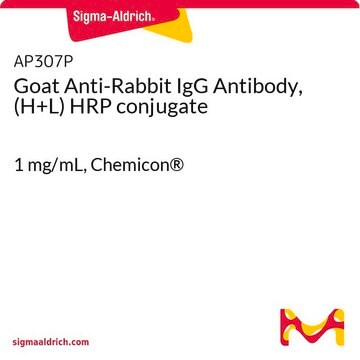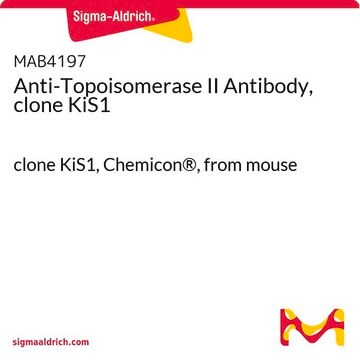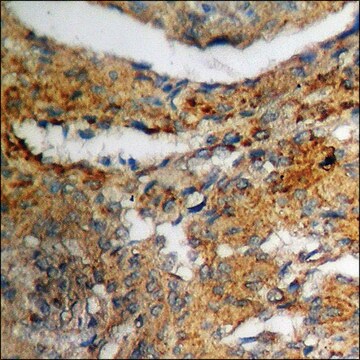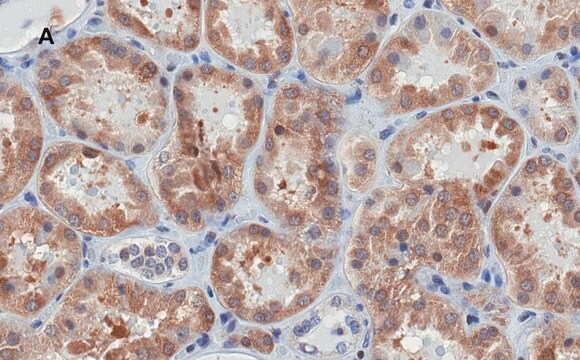일반 설명
We are committed to bringing you greener alternative products, which adhere to one or more of The 12 Principles of Green Chemistry. This antibody is Preservative-free, produced without the harm or sacrifice of animals and exceptionally stable to allow for ambient shipping and storage if needed and thus aligns with "Waste Prevention", "Designing Safer Chemicals" and "Design for Energy Efficiency".
Click here for more information.
ZooMAb® antibodies represent an entirely new generation of recombinant monoclonal antibodies. Each ZooMAb® antibody is manufactured using our proprietary recombinant expression system, purified to homogeneity, and precisely dispensed to produce robust and highly reproducible lot-to-lot consistency. Only top-performing clones are released for use by researchers. Each antibody is validated for high specificity and affinity across multiple applications, including its most commonly used application. ZooMAb® antibodies are reliably available and ready to ship when you need them.
특이성
Clone 1B13 is a ZooMAb® rabbit recombinant monoclonal antibody that specifically detects RIG-1/DDX58. It targets an epitope within 24 amino acids from the N-terminal half.
면역원
KLH-conjugated linear peptide corresponding to 24 amino acids from the N-terminal half of human RIG-1/DDX58.
애플리케이션
Quality Control Testing
Evaluated by Western Blotting in HepG2 cell lysate.
Western Blotting Analysis: A 1:1,000 dilution of this antibody detected RIG-1/DDX58 in HepG2 cell lysate.
Tested Applications
Western Blotting Analysis: A 1:1,000 dilution from a representative lot detected RIG-1/DDX58 in MCF-7 cell lysate.
Immunocytochemistry Analysis: A 1:100 dilution from a representative lot detected RIG-1/DDX58 in HepG2 cells.
Affinity Binding Assay: A representative lot of this antibody bound RIG-I/DDX58 peptide with a KD of 7.8 x 10-7 in an affinity binding assay.
Note: Actual optimal working dilutions must be determined by end user as specimens, and experimental conditions may vary with the end user.
표적 설명
Antiviral innate immune response receptor RIG-I (UniProt: O95786; also known as ATP-dependent RNA helicase DDX58, EC:3.6.4.13, DEAD box protein 58, RIG-I-like receptor 1, RLR-1, RNA sensor RIG-1, Retinoic acid-inducible gene 1 protein, RIG-1) is encoded by the RIGI (also known as DDX58) gene (Gene ID: 23586) in human. RIG-1 is an innate immune receptor that senses cytoplasmic viral nucleic acids and activates a downstream signaling cascade leading to the production of type I interferons and pro-inflammatory cytokines. It detects both positive and negative strand RNA viruses. It is also reported to detect dsRNA produced from non-self dsDNA by RNA polymerase III, such as Epstein-Barr virus-encoded RNAs. It forms a ribonucleoprotein complex with viral RNAs on which it homooligomerizes to form filaments. The homooligomerization allows the recruitment of RNF135, an E3 ubiquitin-protein ligase that activates and amplifies the RIG-I-mediated antiviral signaling in an RNA length-dependent manner through ubiquitination-dependent and -independent mechanisms. It is usually maintained in a monomeric autoinhibited state and is activated upon binding to viral RNAs, which induces a conformational shift. Upon activation, it is reported to associate with mitochondrial antiviral signaling protein (MAVS/IPS1) that activates the IKK-related kinases TBK1 and IKBKE, which in turn phosphorylate the interferon regulatory factors IRF3 and IRF7, activating transcription of antiviral immunological genes including the IFN-α and IFN-β. RIG-1 has two CARD domains (aa 1-87 and 92-172)s and a RLR-CTR domain (aa 794-925). The RLR CTR domain controls its homooligomerization and interaction with MAVS/IPS1. In the absence of viral infection, it is maintained as a monomer in an autoinhibited state with the CARD domains masked through intramolecular interactions with the RLR-CTR domain. Upon binding to viral RNA and ubiquitination by RNF135, a conformational change releases the autoinhibition and promotes further homooligomerization. RIG-1 is reported to be phosphorylated in resting cells and is dephosphorylated in RNA virus-infected cells. Phosphorylation at threonine 770, serine 854 and serine 855 by casein kinase 2 (CK2) results in inhibition of its activity. This ZooMAb® recombinant monoclonal antibody, generated by our propriety technology, offers significantly enhanced specificity, affinity, reproducibility, and stability over conventional monoclonals. (Ref.: Shi, Y., et al. (2017). Nat. Commun. 8; 15138; Sun, Z., et al. (2011). J. Virol. 85(2); 1036-1047; Yoneyama, M., et al. (2004). Nat. Immunol. 5(7); 730-737).
물리적 형태
Purified recombinant rabbit monoclonal antibody IgG, lyophilized in PBS, 5% Trehalose, normal appearance a coarse or translucent resin. The PBS/trehalose components in the ZooMAb formulation can have the appearance of a semi-solid (bead like gel) after lyophilization. This is a normal phenomenon. Please follow the recommended reconstitution procedure in the data sheet to dissolve the semi-solid, bead-like, gel-appearing material. The resulting antibody solution is completely stable and functional as proven by full functional testing. Contains no biocide or preservatives, such as azide, or any animal by-products. Larger pack sizes provided as multiples of 25 µL.
재구성
Reconstitute lyophilized antibody pellet with 25μL of ultrapure water or Phosphate Buffered Saline (PBS). Please refer to our
reconstitution protocol and the specific application guidance on the suggested starting dilutions and sample type.
저장 및 안정성
Recommend storage of lyophilized product at 2-8°C; Before reconstitution, micro-centrifuge vials briefly to spin down material to bottom of the vial; Reconstitute each vial by adding 25 µL of filtered lab grade water or PBS; Reconstituted antibodies can be stored at 2-8°C, or -20°C for long term storage. Avoid repeated freeze-thaws.
기타 정보
Concentration: Please refer to the Certificate of Analysis for the lot-specific concentration.
법적 정보
ZooMAb is a registered trademark of Merck KGaA, Darmstadt, Germany
면책조항
Unless otherwise stated in our catalog or other company documentation accompanying the product(s), our products are intended for research use only and are not to be used for any other purpose, which includes but is not limited to, unauthorized commercial uses, in vitro diagnostic uses, ex vivo or in vivo therapeutic uses or any type of consumption or application to humans or animals.










